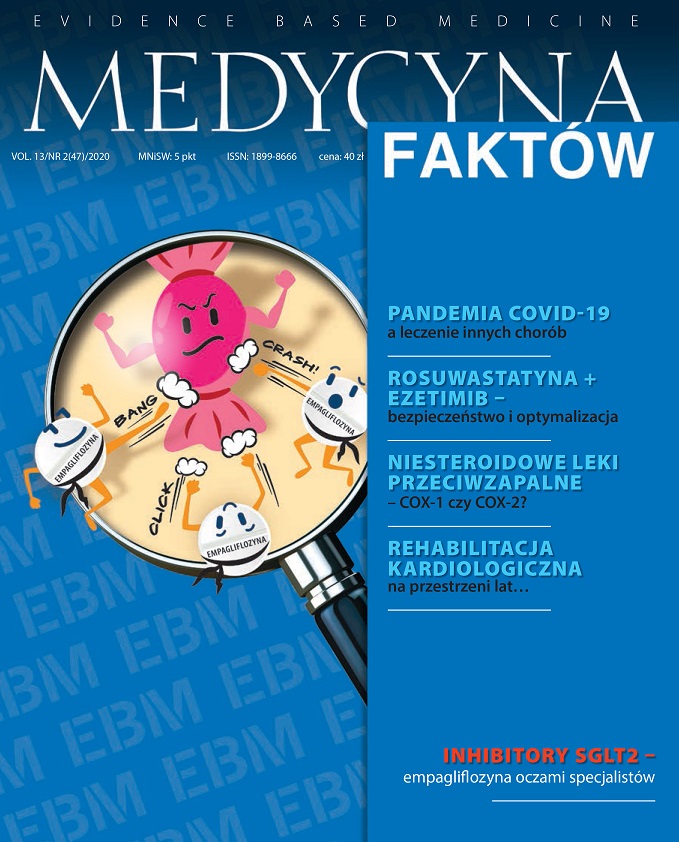Leczenie choroby zwyrodnieniowej stawów w świetle aktualizacji i wytycznych Artykuł przeglądowy
##plugins.themes.bootstrap3.article.main##
Abstrakt
Choroba zwyrodnieniowa stawów (OA, osteoarthritis) jest jedną z najczęstszych przyczyn niepełnosprawności w populacji osób starszych. Głównymi jej objawami są przewlekłe dolegliwości bólowe, utrudniające pacjentowi codzienną aktywność. Podstawą leczenia farmakologicznego są paracetamol oraz niesteroidowe leki przeciwzapalne (NLPZ). Mogą być stosowane w formie doustnej, parenteralnej lub miejscowej. Zgodnie z wytycznymi wielu towarzystw naukowych stosowanie miejscowe jest zalecane jako leczenie pierwszego wyboru ze względu na udowodnioną skuteczność oraz zmniejszone ryzyko wystąpienia powikłań i działań niepożądanych w porównaniu z formą doustną lub parenteralną. Wśród najczęściej stosowanych NLPZ w formie miejscowej wymienia się: diklofenak, ketoprofen, piroksykam, naproksen oraz ibuprofen. W pracy zostaną podkreślone najistotniejsze dane z aktualizacji wytycznych towarzystw naukowych w aspekcie rekomendacji leczenia choroby zwyrodnieniowej stawów. Aktualizowanie wiedzy i wytycznych co kilka lat jest istotne ze względu na mnogość pojawiających się nowych danych naukowych potwierdzających zasadność stosowania poszczególnych terapii lub stwierdzających jej brak.
##plugins.themes.bootstrap3.article.details##
Copyright © by Medical Education. All rights reserved.
Bibliografia
2. Kolasinski SL, Neogi T, Hochberg MC et al. 2019 American College of Rheumatology/Arthritis Foundation Guideline for the Management of Osteoarthritis of the Hand, Hip, and Knee. Arthritis Rheumatol. 2020; 72(2): 220-33.
3. Huskisson EC. Applying the evidence in osteoarthritis: strategies for pain management. Clin Drug Investig. 2007; 27(suppl 1): 23-9.
4. Loeser RF, Goldring SR, Scanzello CR et al. Osteoarthritis: a disease of the joint as an organ. Arthritis Rheum. 2012; 64(6): 1697-707.
5. Sinusas K. Osteoarthritis: diagnosis and treatment. Am Fam Physician. 2012; 85(1): 49-56.
6. McMahon S, Koltzenburg M (ed). Wall and Melzack’s Textbook of Pain. Churchill Livingstone, Edinburgh 2005.
7. Moore RA, Derry S, McQuay HJ. Single dose oral meloxicam for acute postoperative pain in adults. Cochrane Database Syst Rev. 2009(4): CD007552.
8. Ohtori S, Inoue G, Orita S et al. Efficacy of combination of meloxicam and pregabalin for pain in knee osteoarthritis. Yonsei Med J. 2013; 54(5): 1253-8.
9. Nelson AE, Allen KD, Golightly YM et al. A systematic review of recommendations and guidelines for the management of osteoarthritis: The chronic osteoarthritis management initiative of the U.S. bone and joint initiative. Semin Arthritis Rheum. 2014; 43(6): 701-12.
10. Hochberg MC, Altman RD, April KT et al. American College of Rheumatology 2012 recommendations for the use of nonpharmacologic and pharmacologic therapies in osteoarthritis of the hand, hip, and knee. Arthritis Care Res. (Hoboken) 2012; 64(4): 465-74.
11. Birch S, Lee MS, Robinson N et al. The U.K. NICE 2014 Guidelines for Osteoarthritis of the Knee: Lessons Learned in a Narrative Review Addressing Inadvertent Limitations and Bias. J Altern Complement Med. 2017; 23(4): 242-6.
12. Derry S, Wiffen PJ, Kalso EA et al. Topical analgesics for acute and chronic pain in adults – an overview of Cochrane Reviews. Cochrane Database Syst Rev. 2017; 5: CD008609.
13. Erdogan F, Ergun H, Gokay NS et al. The diffusion of nimesulide gel into synovial fluid: a comparison between administration routes. Int J Clin Pharmacol Ther. 2006; 44(6): 270-5.
14. Stanos SP, Galluzzi KE. Topical therapies in the management of chronic pain. Postgrad Med. 2013; 125(4 suppl 1): 25-33.
15. Rannou F, Pelletier JP, Martel-Pelletier J. Efficacy and safety of topical NSAIDs in the management of osteoarthritis: Evidence from real-life setting trials and surveys. Semin Arthritis Rheum. 2016; 45(4 suppl): S18-21.
16. Derry S, Moore RA, Gaskell H et al. Topical NSAIDs for acute musculoskeletal pain in adults. Cochrane Database Syst Rev. 2015; (6): CD007402.
17. Kloppenburg M, Kroon FP, Blanco FJ et al. 2018 update of the EULAR recommendations for the management of hand osteoarthritis. Ann Rheum Dis. 2019; 78(1): 16-24.
18. Altman RD, Dreiser RL, Fisher CL et al. Diclofenac sodium gel in patients with primary hand osteoarthritis: a randomized, double-blind, placebo- controlled trial. J Rheumatol. 2009; 36(9): 1991-9.
19. Woroń J, Wordliczek J, Dobrogowski J. Porównanie niesteroidowych leków przeciwzapalnych (NLPZ). Medycyna po Dyplomie. 2011; 6(183): 55-63.
20. FitzGerald GA, Patrono C. The coxibs, selective inhibitors of cyclooxygenase-2. N Engl J Med. 2001; 345(6): 433-42.
21. Tibesku CO, Daniilidis K, Skwara A et al. Expression of vascular endothelial growth factor on chondrocytes increases with osteoarthritis – an animal experimental investigation. Open Orthop J. 2011; 5: 177-80.
22. Bianchi M, Broggini M, Balzarini P et al. Effects of nimesulide on pain and on synovial fluid concentrations of substance P, interleukin-6 and interleukin-8 in patients with knee osteoarthritis: comparison with celecoxib. Int J Clin Pract. 2007; 61(8): 1270-7.
23. Malec-Milewska M, Woroń J (ed). Kompendium leczenia bólu. Medical Education, Warszawa 2017.
24. Lee T, Lu N, Felson DT et al. Use of non-steroidal anti-inflammatory drugs correlates with the risk of venous thromboembolism in knee osteoarthritis patients: a UK population-based case-control study. Rheumatology (Oxford). 2016; 55(6): 1099-105.
